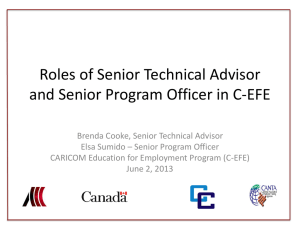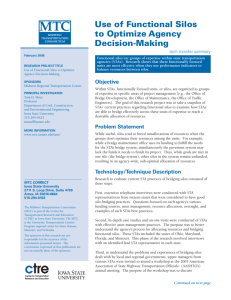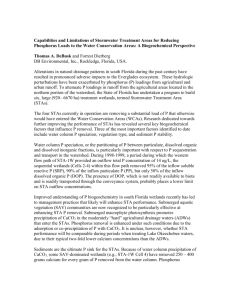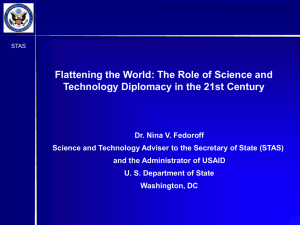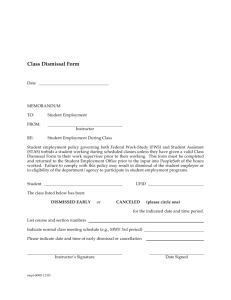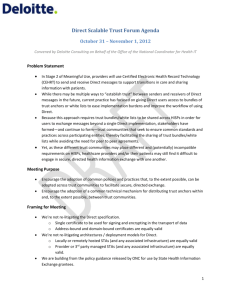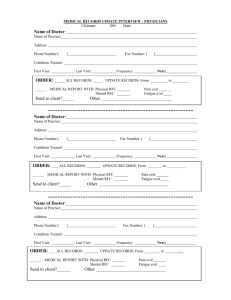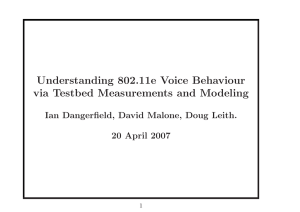Direct Project Applicability Statement v1.1 Proposed Updates
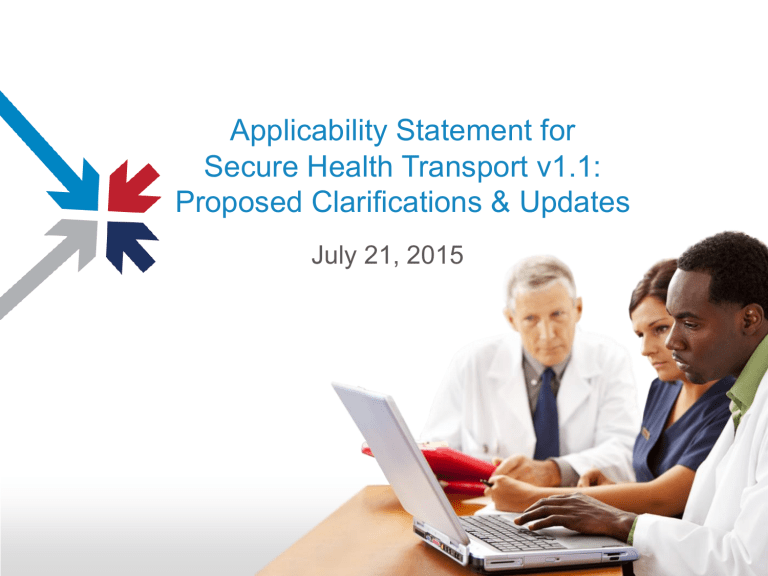
Applicability Statement for
Secure Health Transport v1.1:
Proposed Clarifications & Updates
July 21, 2015
Background
» Feedback received indicates that ambiguities in a few areas of the
Applicability Statement and in underlying standards is resulting in some implementers interpreting certain requirements differently from the majority of the Direct community, resulting in interoperability challenges.
» The Implementation Geographies Workgroup (IGW) in conjunction with the Reference Implementation Workgroup (RIW) is proposing a round of updates to the Applicability Statement v1.1. The principal focus of these updates is to improve interoperability by correcting errors within the document and clarifying areas of ambiguity.
http://wiki.directproject.org/file/detail/Applicability+Statement+for+Secur e+Health+Transport+v1.2-DRAFT-2015071701.docx
(track changes is “on” to indicate updates to v1.1)
2
Proposed Error Corrections and
Clarifications
3
Proposed Error Corrections
» The proposed updates include corrections to errors occurring throughout the document, such as:
• Spelling and grammar. Example: patient should be patent in IPR
Statement.
• RFC references. Example: RFC 5751 section 2.2 should be RFC 5751 section 2.7 in Section 2.7.
• Technical references. Example: SMTP RCPT FROM and MAIL TO should be SMTP RCPT TO and MAIL FROM in Section 2.4.
» While each correction is minor, as a whole, addressing these will help clear up confusion that has originated from time to time when new implementers have attempted to identify pertinent requirements and conform to the Applicability Statement.
4
Areas of Proposed Clarifications
Feedback has pointed to ambiguities in four areas that would benefit from clarification:
1.
Message signatures
2.
Message digest generation and verification
3.
Message Disposition Notifications (MDNs) and mail system reports
4.
Subject verification for digital certificates
5
Message Signatures
Additional language has been introduced in Section 2.5.1 to clear up any ambiguities as to the allowable format and media type values for message signatures:
» Emphasizes that, while RFC 5751 defines multiple formats for signed messages, STAs MUST create and accept signed messages in the multipart/signed format as defined by RFC 5751, section 3.4.3.
» Fleshes out media type requirements with more context:
In addition to the standard media type of application/pkcs-signature required by
RFC 5751 for the detached signature body part, to preserve interoperability with legacy systems, STAs also MUST be able to accept a media type of application/x-pkcs7-signature.
6
Message Digest Generation & Verification
Message digests enable an STA to determine if a message may have been modified in transit. While STAs are required by RFC 5751 to generate digests for sent messages and verify integrity of received messages using digests, reports have been received that some STAs in the field may not be correctly generating digests or verifying them. The proposed updates draw attention to RFC 5751’s requirements:
» Section 2.5.3, Digest Generation and Verification (new section):
Points out that message digests MUST be computed per RFC 5751, including the canonicalization described in Section 3.1.1 of that RFC.
» Section 3.2, Processed Notifications:
Clarifies that a message MUST have a valid digest in order for a receiving STA to send a processed MDN.
7
MDNs and Mail System Reports
We received consistent feedback that it was not apparent from Section 3 of the Applicability Statement what requirements pertained to notifications as a whole versus just to processed MDNs.
» As a result…
•
Some STAs are not sending processed MDNs under the conditions intended by the
Applicability Statement, and
• Some STAs might be issuing Delivery Status Notifications (another form of notification aside from MDNs often used by mail systems, including STAs) outside of the Direct standard since Section 3 doesn
’t name DSNs specifically.
» Section 3 is proposed to be restructured to clarify this, with 3.0 addressing requirements pertinent to all mail system reports (both MDNs and DSNs), 3.1 detailing additional constraints and changes to underlying RFCs related to
MDNs and DSNs, and 3.2 containing the requirements specific to processed
MDNs.
8
Subject Verification for Digital Certificates
Feedback was received that the requirements around subject verification of certificates as written could lead to possible interpretations at odds with other requirements in the Applicability Statement.
» Section 1.4 states that Direct Address-bound certificates MUST be assigned to the address by binding it to the subjectAltName extension rfc822Name.
» However, Section 4.1.1 currently reads as a series of “if’s” that could be interpreted as if the subjectAltName rfc822Name is optional, and even that a valid address-bound certificate does not have to have any of the stated characteristics:
1.
If the subjectAltName extension is present and an rfc822Name is included then it contains the e-mail address.
2.
If the Subject Distinguished Name contains an EmailAddress legacy attribute, then it contains the e-mail address.
3.
If both of the previous locations contain an e-mail address, they must match
» This was not the intent, and so the proposed updates address this and align
Section 4.1.1 with Section 1.4.
9
Subject Verification for Digital Certificates (cont.)
Feedback also was received that the requirements as currently worded around subject verification lead to tension with other requirements in the Applicability
Statement, supporting RFCs, and community practices in the field.
»
Requirements in Sections 4.0 and 4.1.1 today stipulate that STAs must perform a casesensitive comparison of the Health Endpoint Name (local-part) of a Direct address (the part to the left of the “@”) with the local-part of the rfc822Name.
»
However:
• SMTP RFCs (5321 most current) states that “case sensitivity of mailbox local-parts impedes interoperability and is discouraged .”
• The Applicability Statement requires that STAs MUST be able to discover certificates using the
DNS. Comparisons within the DNS ignore case, hence local-part comparisons for discovery purposes are case-insensitive.
• As a result of the above and in an effort to minimize confusion of users and potential incompatibilities with other systems, when performing subject verification, the Direct Project software reference implementations (both Java and .NET), the NIST Transport Test Tool, and the
SITE Direct Certificate Discovery Tool compare local-parts case-insensitively.
» The proposed updates address this tension by indicating that the matching of the localpart of a Direct address to the local-part of the rfc822Name is to be done using a caseinsensitive comparison.
10
Additional Updates Proposed
11
Additional Updates Being Proposed
While the principal purpose of this round of proposed updates is to provide greater clarity to the Applicability Statement, the IGW and RIW team also recommend a few additional updates. These are recapped below.
» Section 2.4, Signed and Encrypted Health Content Containers: Would recommend that sending STAs protect outer, non-content-related message header fields by wrapping the message as specified in Section 3.1 of RFC
5751, in effect elevating a MAY for sending STAs in RFC 5751 to a SHOULD.
» Section 2.6, Digest Algorithms: Would acknowledge the industry-wide deprecation of SHA-1 by disallowing its use when creating digital signatures
(although still recommending receiving STAs support it for incoming messages to support backwards compatibility). Since the drafting of v1.0 of the
Applicability Statement , it’s become known that SHA-1 is subject to potential collision vulnerabilities. As a result, NIST has already deprecated it’s use, and industry is following.
12
Additional Updates Being Proposed (cont.)
» Section 3.3, Failure Notifications: Would define a standard (optional) way to communicate failure conditions through basic failure notifications. Receiving
STAs are using failed MDNs and DSNs to notify sending STAs of errors today, but with no standard guidance in place, it can be challenging for STAs to consistently process and understand them.
» Section 4.0, Trust Verification: Would recommend that issuers of certificates used in Direct should publish certificate status for discovery by STAs, which at a minimum would include regular publication of CRLs. While STAs today
“MUST have a method for discovering certificate status, which is strongly
RECOMMENDED to include OCSP and retrieval and storage of CRLs, ” there is no corresponding obligation on certificate issuers to publish such status. This recommendation would help close the loop.
» Section 4.2.2, Certificate Paths: Would require STAs to support the Authority
Information Access (AIA) extension in certificates (i.e., elevate a SHOULD to a
MUST). This requirement would be elevated to guarantee a consistent, reliable way across STAs and communities to build certificate chains for determining trust.
13
Discussion / Q&A
14
Next Steps
» A page will be created on the wiki as a follow-up to this meeting. A link will be sent out via the wiki’s messaging system.
» For the remainder of the week, if you have any questions or comments as you review the proposed updates, please post them to the discussion list associated with the page so that everyone has a central place from which to engage.
» Based on how discussion proceeds, we may schedule a follow-up meeting to this one.
» The goal will be to issue a call for consensus by Direct Project committed members later next week.
15
